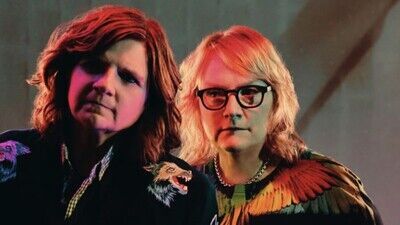Ray and Saliers met in grade school, and Amy was drawn to the guitar-playing Emily, who was a year older. They started making cassette recordings together; singing, harmonizing, and writing songs. The chemistry was immediate. There was a gap when they went to different colleges, but both ended up at Emory University, picking up where they left off. Atlanta was their stomping ground. They had no manager, but they had drive, as well as a passionate local fan base. It was the mid-’80s. They were different from what else was out there: close harmonies, two acoustic guitars, poetic lyrics, a distinct sound. Amy’s voice is rough and guttural. Emily’s voice is clear and high, with a wistful quality. The blend of these opposite essences is the Indigo Girls sound.
In 1989 came “Closer to Fine,” their breakout hit. I still remember where I was when I heard it for the first time (on the radio at the grocery store in Beacon Hill where I was a cashier). The harmonies stopped me in my tracks and the lyrics were so unusual they forced you to listen. Michael Stipe brought them on tour with R.E.M. Mainstream success was disorienting, with unusual stresses and tensions. Ray and Saliers are lesbians, and they had discussions about coming out publicly. When they finally did, a reporter framed it as “This is the year you’ve come out.” Amy interrupted, “I’ve been out.” The homophobic atmosphere of the 1980s can’t be overstated, with AIDS still decimating a generation, and almost no public figures declaring themselves. There were other artists dealing with similar things, either directly before the Indigo Girls or directly after, none of whom get name-checked in “It’s Only Life After All”.
There’s a claustrophobia in the documentary’s approach, even a laziness. Ray and Saliers are the sole interview subjects. The “talking head” format is a tired cliche, but “It’s Only Life After All” would have benefited from more voices, industry voices, cultural voices, who could “place” the Indigo Girls in a wider context. What was going on around them? What part of the folk tradition did they fit into (or not)? At one point, Amy jokes, “Is there a category for Lesbian Christian Folk?” There is clear Christian imagery in many of their songs, and yet this intriguing comment is never followed up on. Why? There’s a moment where Amy talks about the “folk scene” in the mid-’80s, and how it was mostly “quiet,” “intellectual,”, “serious,” whereas they were loud and raucous. To illustrate this point, Bombach inexplicably inserts a clip of Judy Collins in what looks like the late-’60s, sitting on a stool playing guitar, hair down her back. This is to show what the Indigo Girls didn’t want to be, presumably. Judy Collins’ heyday was 20 years before the Indigo Girls came along. Neither Ray nor Saliers mention “Judy Collins” as an artist they didn’t want to emulate. Don’t dis a folk legend to make your point.

